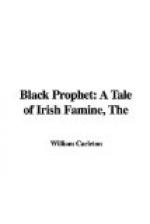In this manner were the people led first into folly, and ultimately into rioting and crime; for it is not, in point of fact, those who are suffering most severely that take a prominent part in these senseless tumults, or who are the first to trample upon law and order. The evil example is set to those who do suffer by these factious vagabonds; and, under such circumstances, and betrayed by such delusions, the poor people join the crowd, and find themselves engaged in the outrage, before they have time to reflect upon their conduct.
At the time of which we write, however, the government did not consider it any part of its duty to take a deep interest in the domestic or social improvement of the people. The laws of the country, at that period, had but one aspect—that of terror; for it was evident that the legislature of the day had forgotten that neither an individual nor a people can both love and fear the same object at the same time. The laws checked insubordination and punished crime; and having done this, the great end and object of all law was considered to have been attained. We hope, however, the day has come when education, progress, improvement and reward, will shed their mild and peaceful lustre upon our statute-books, and banish from them those Draconian enactments, that engender only fear and hatred, breathe of cruelty, and have their origin in a tyrannical love of blood.
We have said that the aspect of the country was depressing and gloomy; but we may add here, that these words convey but a vague and feeble idea of the state to which the people at large were reduced. The general destitution, the famine, sickness and death, which had poured such misery and desolation over the land, left, as might be expected, their terrible traces behind them. Indeed the sufferings which a year of famine and disease—and they usually either accompany or succeed each other—inflicts upon the multitudes of poor, are such as no human pen could at all describe, so as to portray a picture sufficiently faithful to the dreary and death-like spirit which should breath in it. Upon the occasion we write of, nothing met you, go where you might, but suffering, and sorrow, and death, to which we may add, tumult, and crime, and bloodshed. Scarcely a family but had lost one or more. Every face you met was an index of calamity, and bore upon it the unquestionable impressions of struggle and hardship. Cheerfulness and mirth had gone, and were forgotten. All the customary amusements of the people had died away. Almost every house had a lonely and deserted look; for it was known that one or more beloved beings had gone out of it to the grave. A dark, heartless spirit was abroad. The whole land, in fact, mourned, and nothing on which the eye could rest, bore a green or a thriving look, or any symptom of activity, but the churchyards, and here the digging and delving were incessant—at the early twilight, during the gloomy noon, the dreary dusk, and the still more funeral looking light of the midnight taper.




